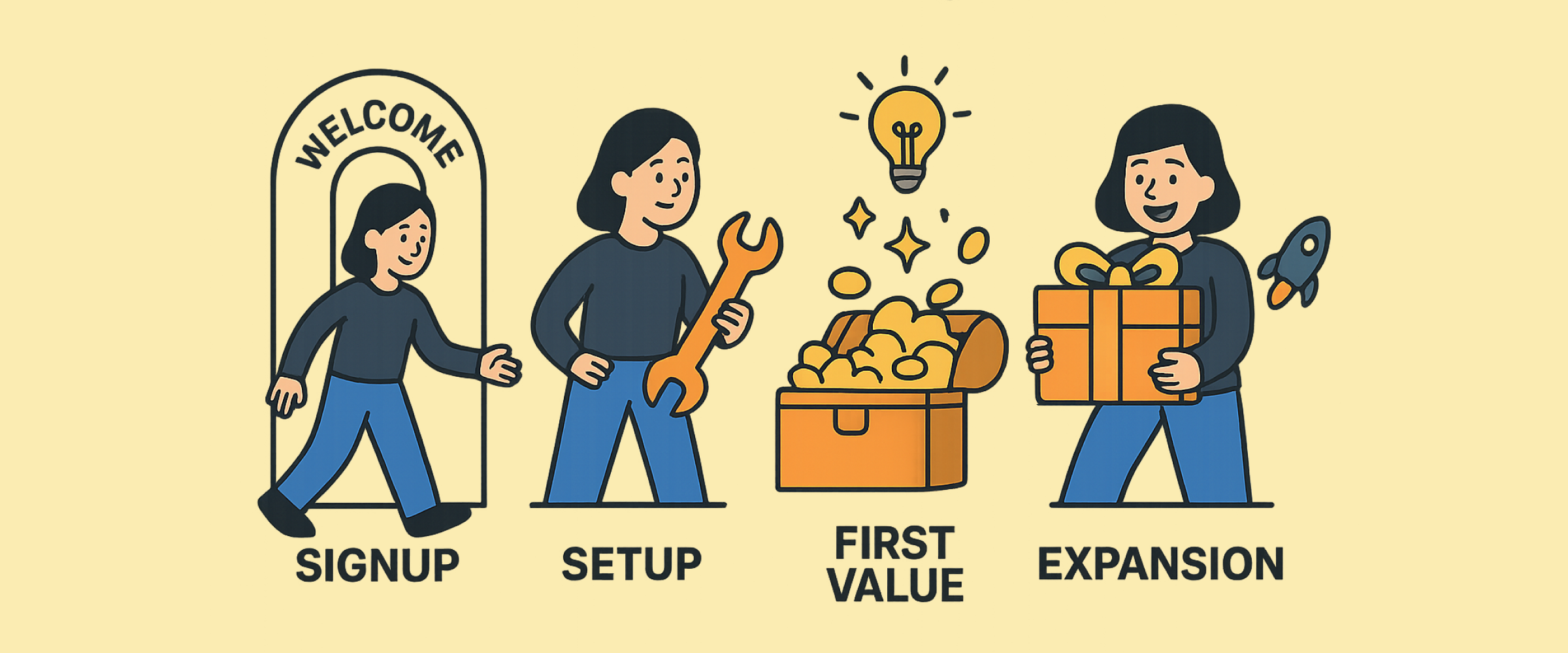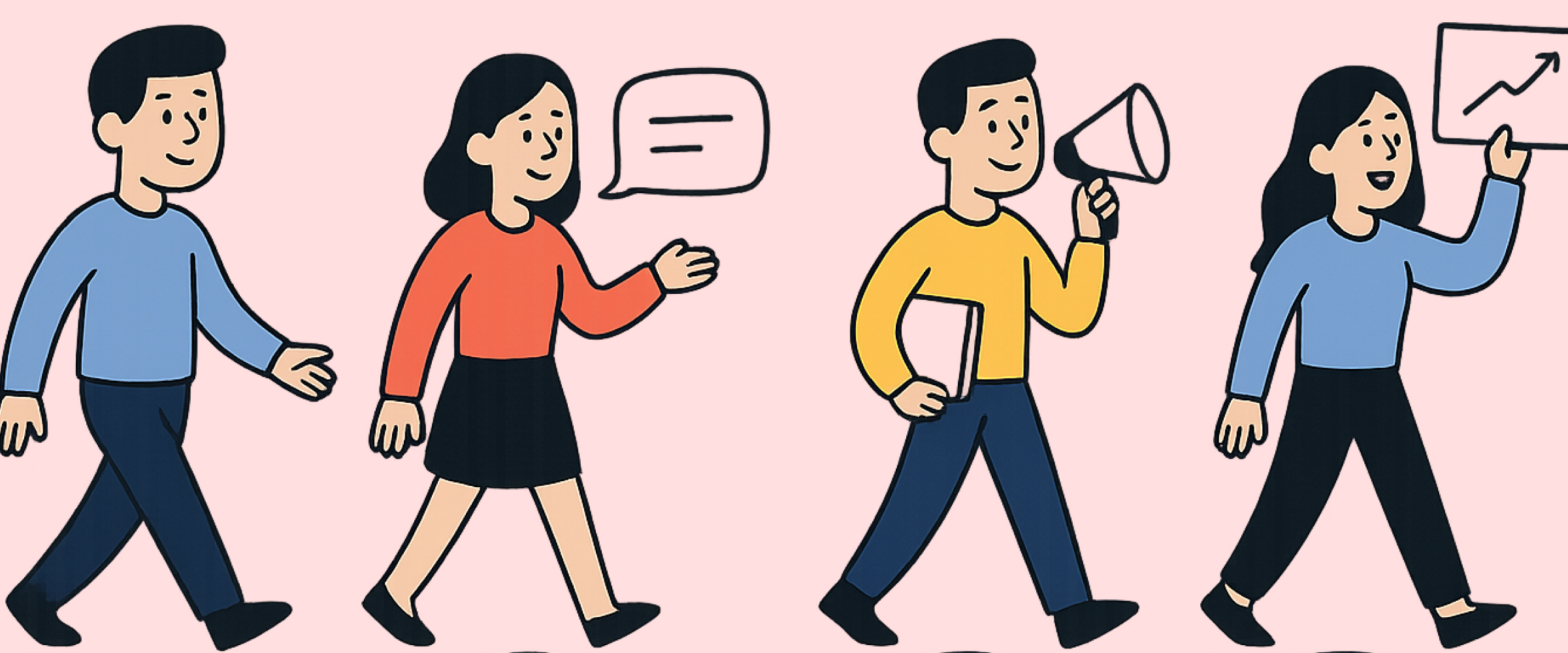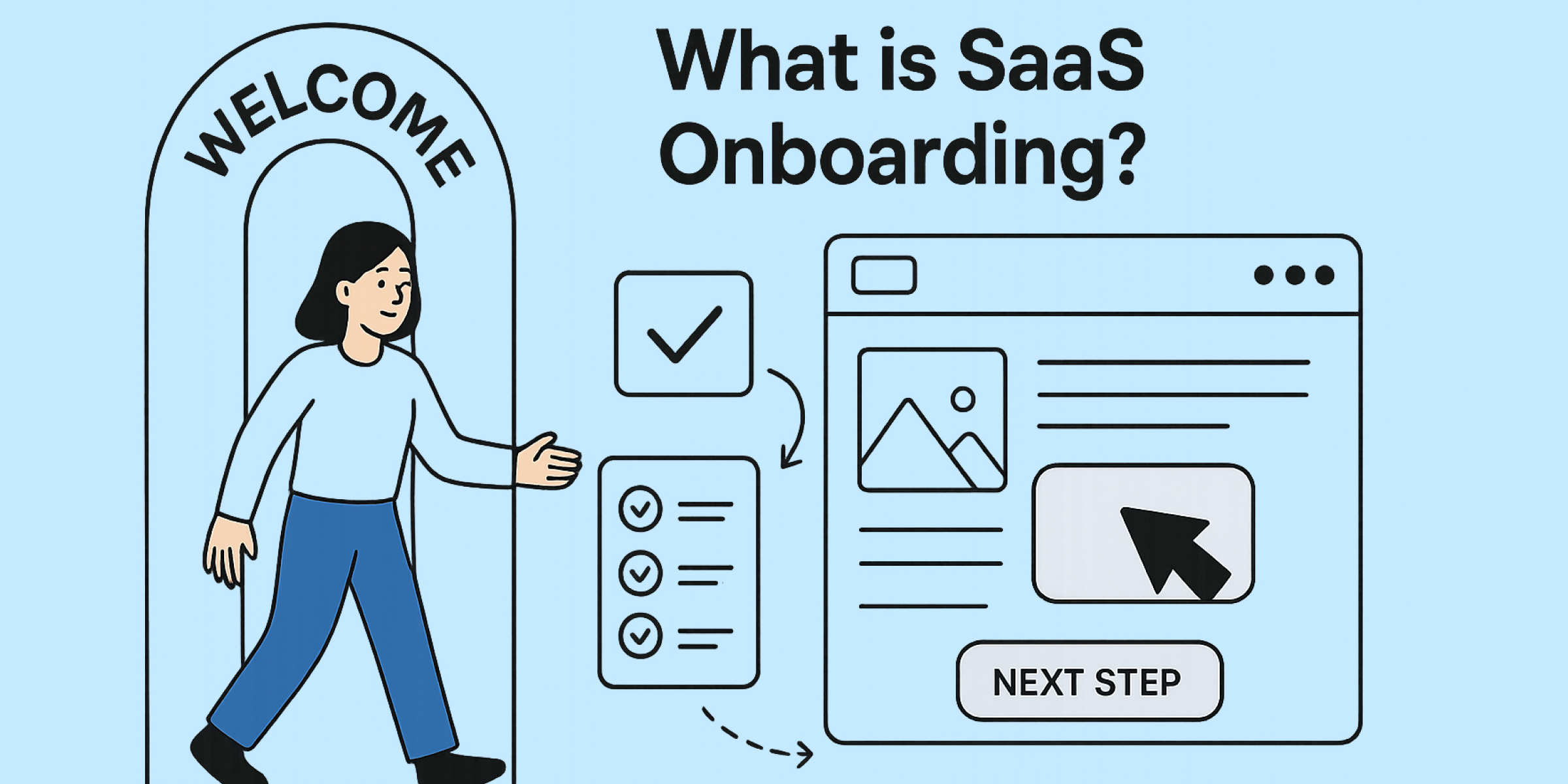The SaaS market is more competitive than ever, and winning a customer doesn’t end at sign-up. Many products lose users in the first days because customers never reach their first moment of value. This makes onboarding one of the most critical drivers of adoption and retention.
So, what is saas onboarding and why does it matter? In this article, we’ll break down the meaning of SaaS onboarding, the typical stages of the saas onboarding process, and how the right tools and strategies can shorten time-to-value and increase customer success.
What is SaaS Onboarding?
SaaS onboarding is the process of guiding new users through their first interactions with your product so they can quickly see its value. When people search for what is saas onboarding, they usually want to understand how software companies help customers move from sign-up to adoption without friction. Unlike a simple tutorial, SaaS onboarding covers the entire journey—from account setup and product configuration to the first “aha” moment when a customer experiences the promised benefit.
Effective saas user onboarding is more than feature training. It sets the foundation for long-term customer success by ensuring users achieve their goals as early as possible. In fact, studies show that 55% of users stop using a product simply because they don’t understand it, and 75% are likely to quit if onboarding is difficult in the first week. Conversely, companies with a complete onboarding flow see retention rates improve by up to 80% and churn reduced by 15–20%. Importantly, many teams are extending onboarding even before sign-up, offering interactive walkthroughs that showcase the product’s core value and help prospects feel more confident about registering.
In many cases, the saas onboarding process also includes human touchpoints such as welcome emails, kickoff calls, or support check-ins. By blending automation with personalized guidance, companies can deliver a smooth introduction that builds trust and accelerates product adoption. Put simply, SaaS onboarding is not just about teaching functionality—it’s about helping new customers succeed quickly. Companies that invest in a structured onboarding approach consistently see higher activation rates, better engagement, and improved retention.

Why SaaS Onboarding Matters for Growth
SaaS onboarding is more than just a series of tutorials or welcome emails—it directly impacts customer retention, churn rates, and long-term value (LTV). Companies that get their onboarding process right can see a significant reduction in churn, which is often the primary culprit behind lost revenue.
A smooth SaaS onboarding process ensures that users understand the product’s core value early on, shortening the time to value. The quicker customers experience the “aha” moment, the more likely they are to stick around and become loyal users. On the flip side, long or complicated onboarding flows can frustrate users and lead them to abandon the product altogether.
In B2B SaaS, especially with complex tools, providing clear, value-driven onboarding is crucial for growth. It’s not just about teaching features; it’s about enabling users to quickly see how the product will help solve their problems. Investing in an effective onboarding strategy can, therefore, be one of the best growth strategies a SaaS company can adopt.

The SaaS Onboarding Process Explained
The SaaS onboarding process is typically broken down into four key stages: Signup, Setup, First Value, and Expansion. These stages provide a roadmap for guiding users through their journey, from initial sign-up to becoming fully engaged with the product.
- Signup: This is the first point of contact where users create their accounts and gain access to your platform. It’s critical to make the process as seamless as possible, as this is the first impression of your product.
- Setup: During this stage, users configure the product to fit their needs. It’s important to provide them with helpful resources or onboarding support, such as setup checklists or tutorials. Tools like Snapdemo can be particularly effective at this stage, offering real-time interactive demos that help users understand the setup process without feeling overwhelmed.
- First Value: This is where users experience the first key benefit of your product. Whether it’s sending their first message or completing a task, ensuring this moment happens quickly is crucial for retention. At this stage, demonstrating immediate value is key to keeping users engaged and encouraging them to explore more. This is where a product walkthrough or demo can make all the difference, allowing users to visualize the value of the product right from the start.
- Expansion: Once the user has seen the product's value, the focus shifts to getting them to explore more features and integrate the product deeper into their daily workflow.
Each of these stages of onboarding SaaS plays a vital role in converting a new user into a loyal customer. By understanding these SaaS onboarding phases, you can identify where users might drop off and optimize those points to increase engagement and retention.
Tip: Mapping these stages to your customer journey will help you create a smoother, more impactful onboarding flow.

Key Elements of an Effective SaaS Onboarding Flow
An effective SaaS onboarding flow includes several key components that help users quickly understand the product’s value and become active users.
- Welcome Emails: These emails set the tone for the onboarding experience. They should be friendly and provide users with immediate next steps to get started.
- Product Walkthroughs (Interactive Demos): These in-app tutorials or tours guide users through the platform’s most important features, helping them achieve their first success faster. Interactive demos can significantly reduce confusion and improve user engagement.
- In-App Guidance: Tooltips, banners, and pop-ups offer contextual guidance to users as they navigate the product, ensuring they don’t get stuck or overwhelmed.
- Support Touchpoints: Offering easy access to support—whether through live chat, email, or knowledge base—ensures users feel supported throughout the onboarding process.
These elements all contribute to a streamlined user onboarding process SaaS by reducing friction and accelerating time-to-value. The quicker users can see value from the product, the more likely they are to continue using it and integrate it into their daily routine.
Investing in a well-structured onboarding flow is crucial for reducing churn and ensuring long-term customer success.

Designing the Ideal SaaS Onboarding Journey
Designing the ideal SaaS onboarding journey starts with understanding the different personas that will be interacting with your product. For instance, the onboarding process for sales, customer success, product marketing, and growth marketing may vary significantly, and each persona should have a tailored experience. By segmenting your users and designing onboarding flows that cater to each role, you can ensure that all users have an optimized experience.
Tools like Snapdemo make it easier to create tailored onboarding journeys by offering personalized product demos for different user roles. This ensures that each user receives a relevant and impactful experience from the moment they sign up, guiding them through features that are most valuable to them.
One of the best practices for designing an effective onboarding journey is to keep it personalized. Personalization helps users feel more engaged and valued, which increases retention and reduces churn. Another key aspect is to simplify the process. Overcomplicating onboarding will only frustrate users and prolong their time to value. By reducing unnecessary steps and focusing on core features, you can make it easier for users to experience the benefits quickly. The best SaaS onboarding experiences are also data-driven. By leveraging analytics and user feedback, you can continuously improve the onboarding journey to meet user needs and expectations. Snapdemo offers built-in analytics that allow you to track user interactions in real-time, providing valuable insights into how users engage with the product. A data-driven approach like this ensures that users are guided through the most relevant features based on their specific use cases, helping you optimize the onboarding process more effectively.
So, what should the saas onboarding experience look like? It should be seamless, personalized, and designed with the user’s goals in mind—leading them to their first “aha” moment as quickly as possible.

Common Mistakes to Avoid
While an effective onboarding journey can drive user retention and success, there are some common mistakes that can derail the process. One of the most significant mistakes is creating an overly long onboarding flow. Lengthy onboarding can overwhelm users and cause them to disengage before they see any value from the product.
Another common pitfall is information overload. While it’s important to provide helpful resources, bombarding users with too much information at once can lead to confusion and frustration. Instead, break the content into digestible, manageable chunks.
Finally, many companies fail to prioritize customer support during onboarding. Without accessible support, users may feel lost or unsure of how to proceed, leading to frustration and abandonment. It’s critical to ensure that users have easy access to help at every step of the journey.
To summarize, focusing on simplicity, clear value messaging, and robust support can help prevent these common mistakes and ensure your SaaS onboarding process is successful.

Conclusion
In conclusion, SaaS onboarding is a critical process that can make or break the user experience. A seamless, well-designed onboarding journey not only helps users understand the value of the product quickly, but it also fosters long-term customer retention. By investing in a thoughtful onboarding process, SaaS companies can reduce churn, increase time to value, and ultimately drive business growth.
The success of your product depends largely on the initial experience you offer to users. If you can ensure that new customers experience their first value quickly, they are much more likely to become loyal, long-term users. Whether through automated workflows or personalized touchpoints, optimizing your onboarding journey will pay off in the form of higher customer satisfaction, better engagement, and increased revenue.
FAQ
What should the SaaS onboarding experience look like?
The ideal SaaS onboarding experience should be personalized, simple, and focused on delivering value as quickly as possible. A great onboarding experience ensures users understand how the product solves their problems, guiding them smoothly through the process without feeling overwhelmed.
What are the stages of onboarding in SaaS?
The stages of onboarding in SaaS typically include: Signup, Setup, First Value, and Expansion. Each stage plays a crucial role in helping users get familiar with the product, while ensuring they experience the value quickly to enhance retention.
What is the process of onboarding new customers to a SaaS?
The process of onboarding new customers to a SaaS product typically involves guiding users through account creation, setting up the product, providing initial training or walkthroughs, and ensuring they achieve their first success quickly to move toward deeper engagement.
What are the phases of SaaS onboarding?
The phases of SaaS onboarding include:
- Initial contact and sign-up
- Product setup and customization
- First value experience
Ongoing usage and expansion
Each phase is important for ensuring users progress smoothly toward full adoption of the product.
How long does SaaS onboarding usually take (time to value)?
The time it takes to onboard a user varies by product and complexity, but ideally, SaaS onboarding should lead users to their first “aha” moment within the first few days. Reducing time to value is crucial to retaining users and ensuring they quickly realize the benefits of the product.

